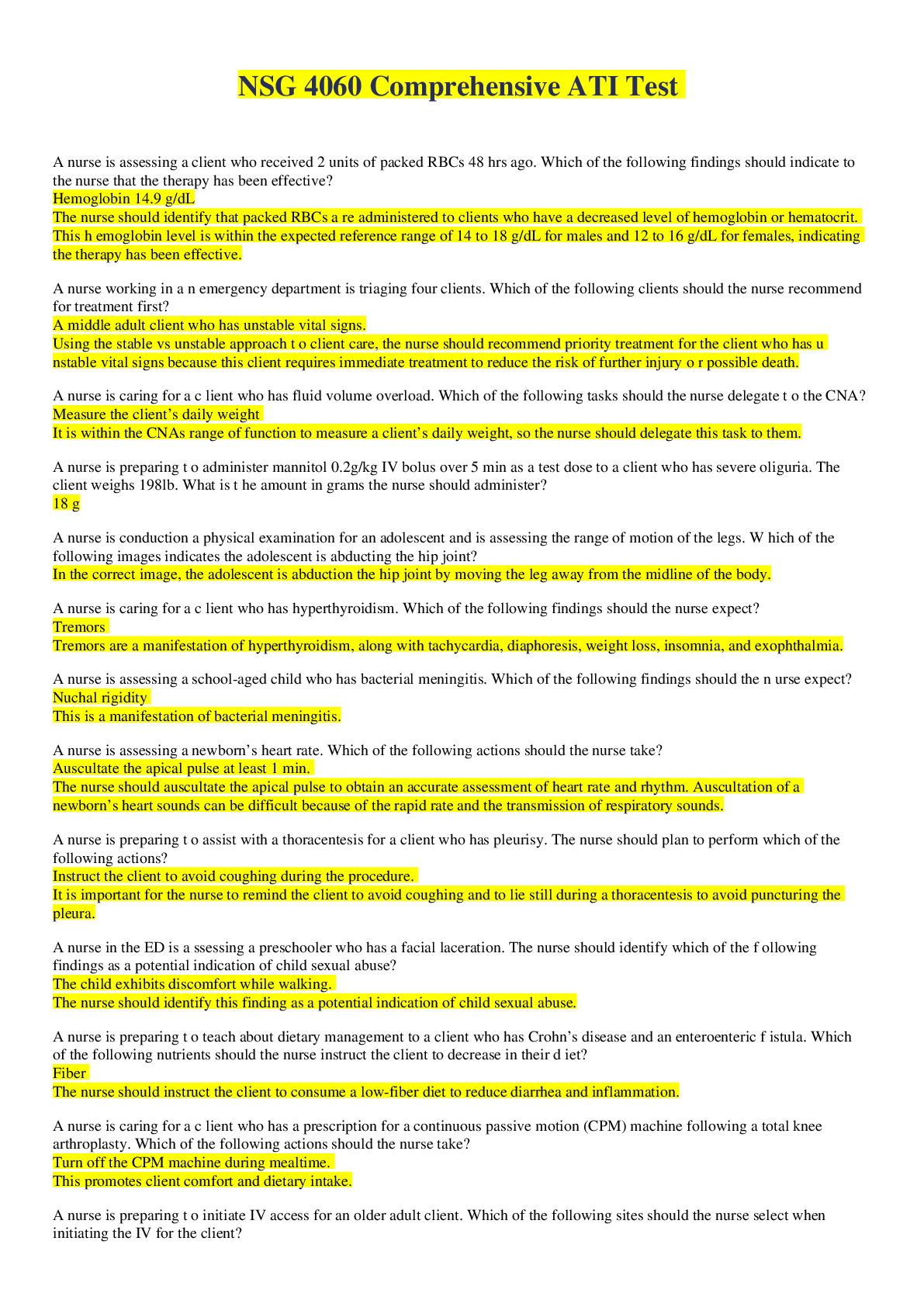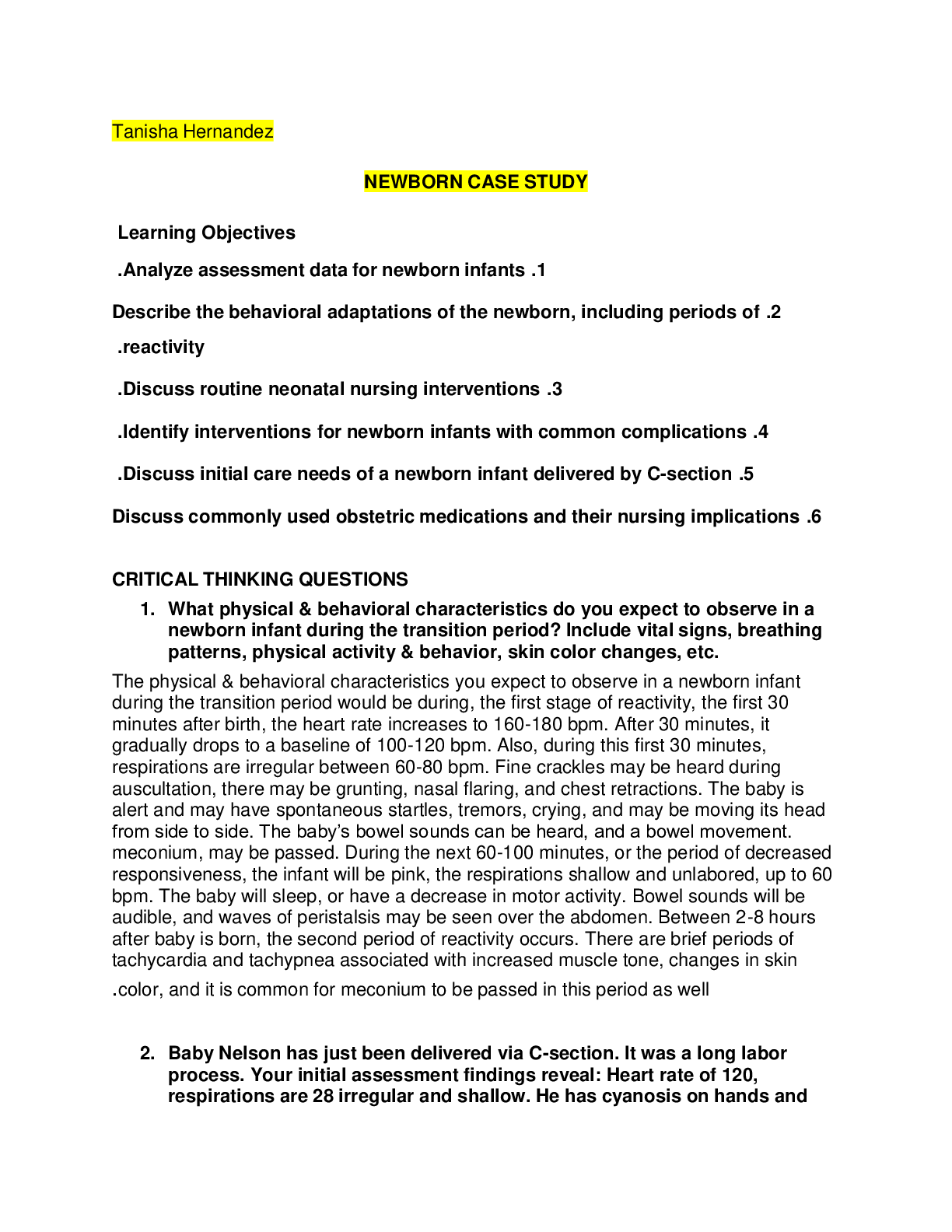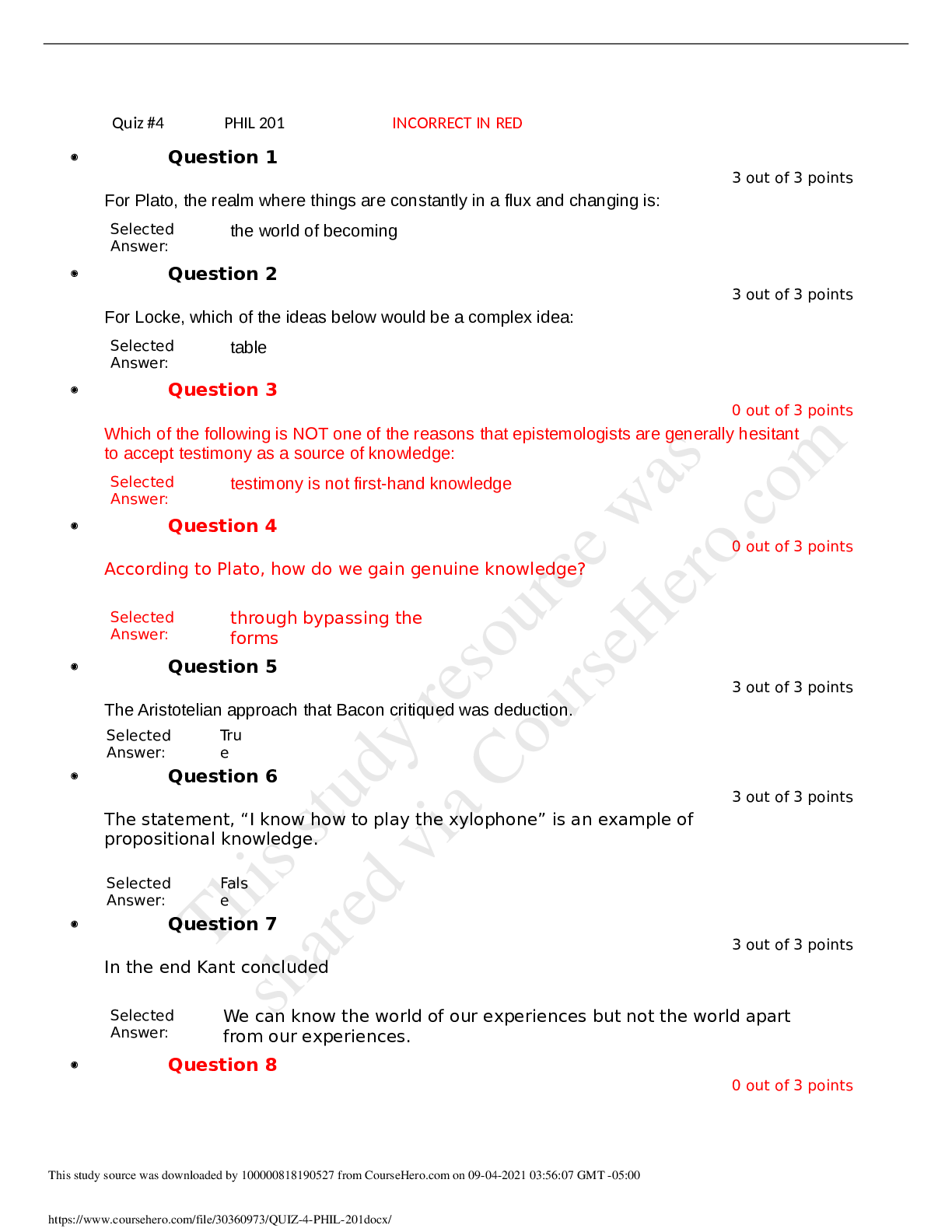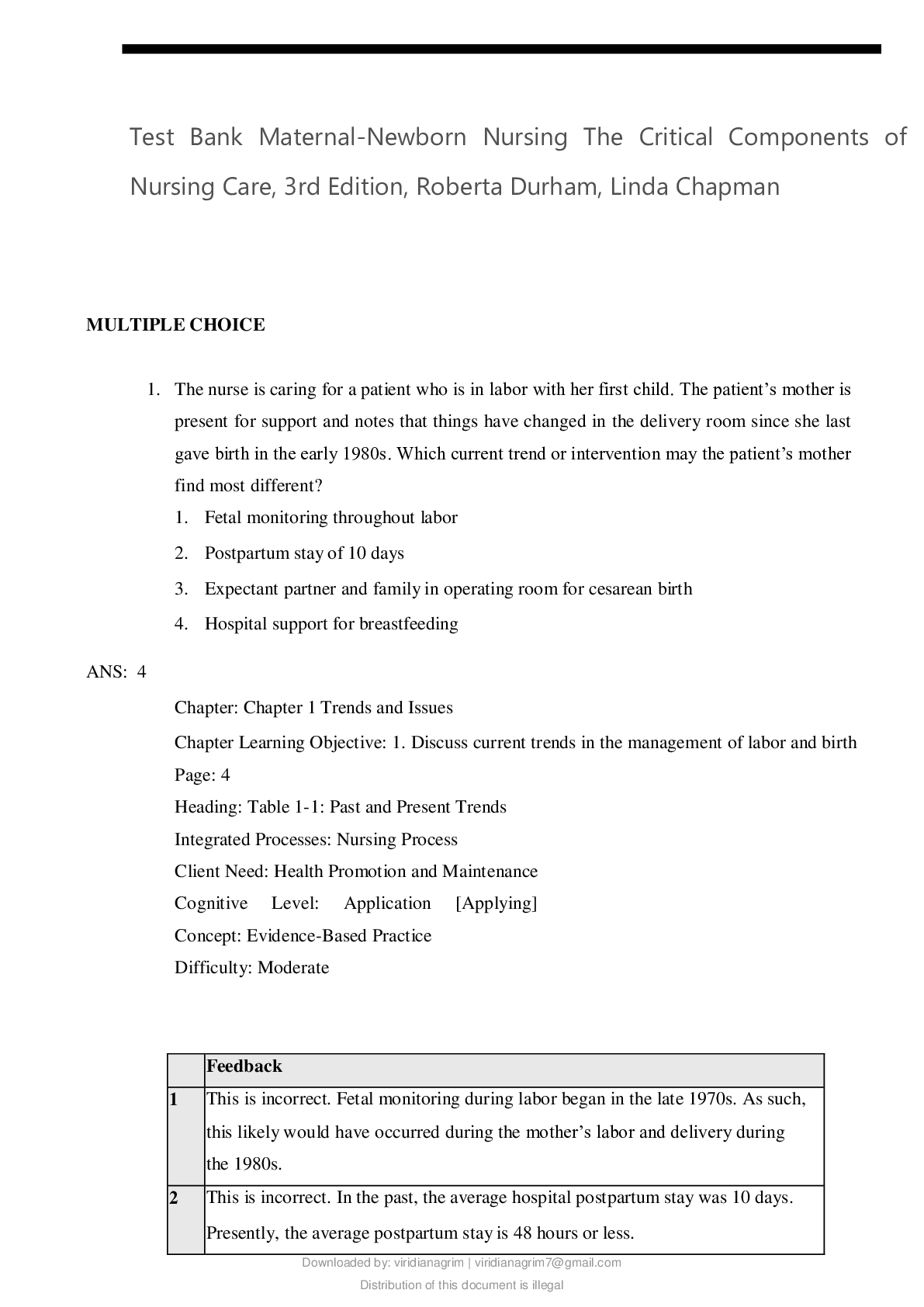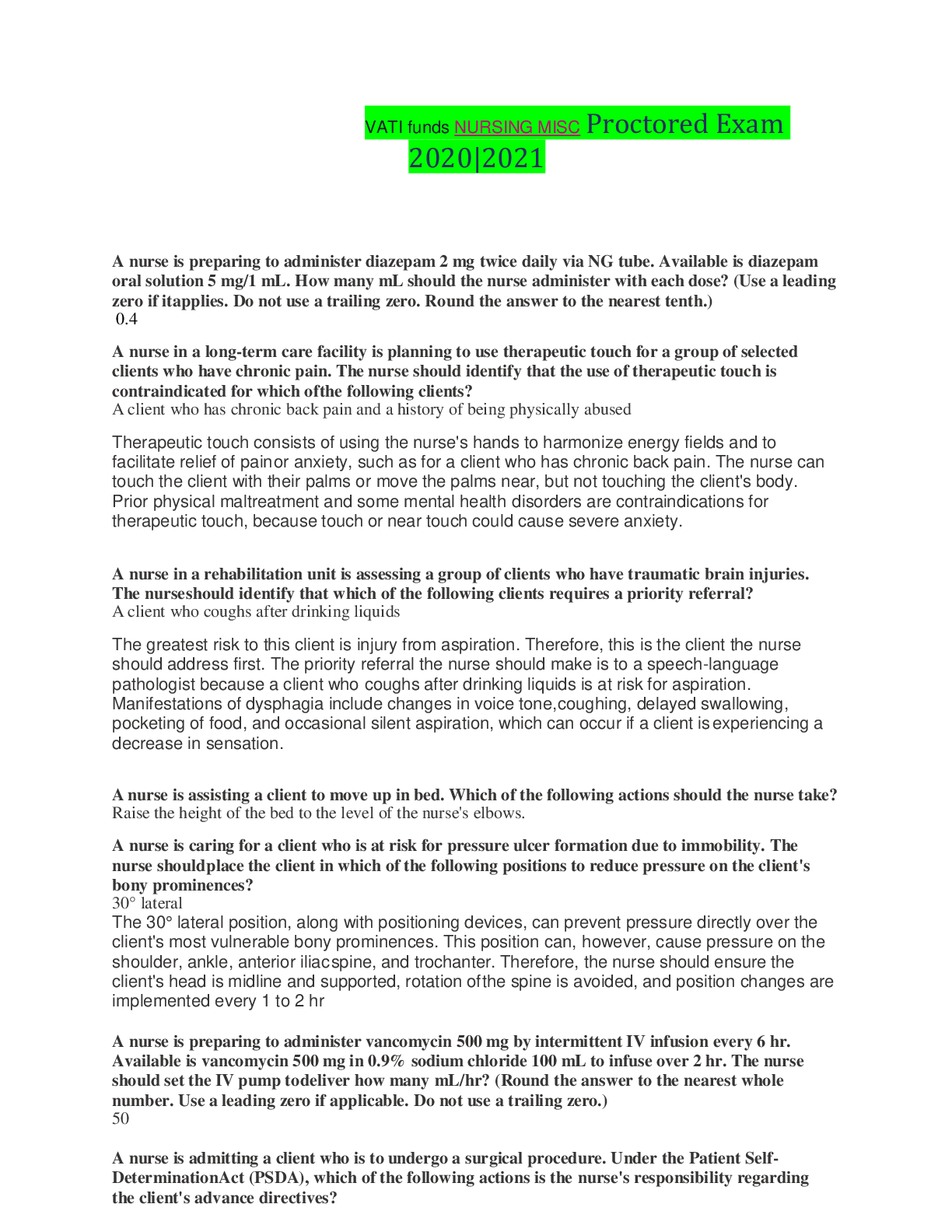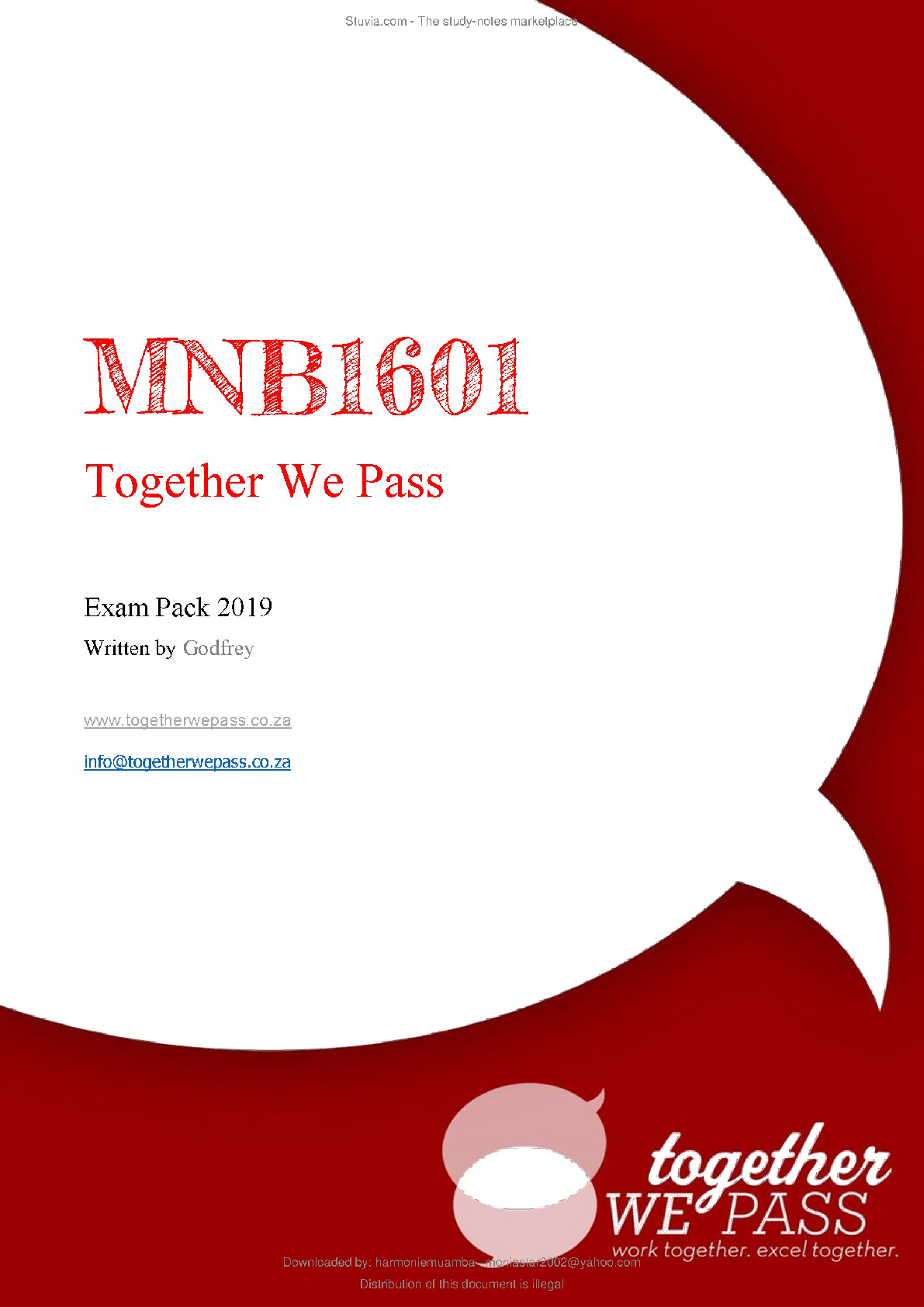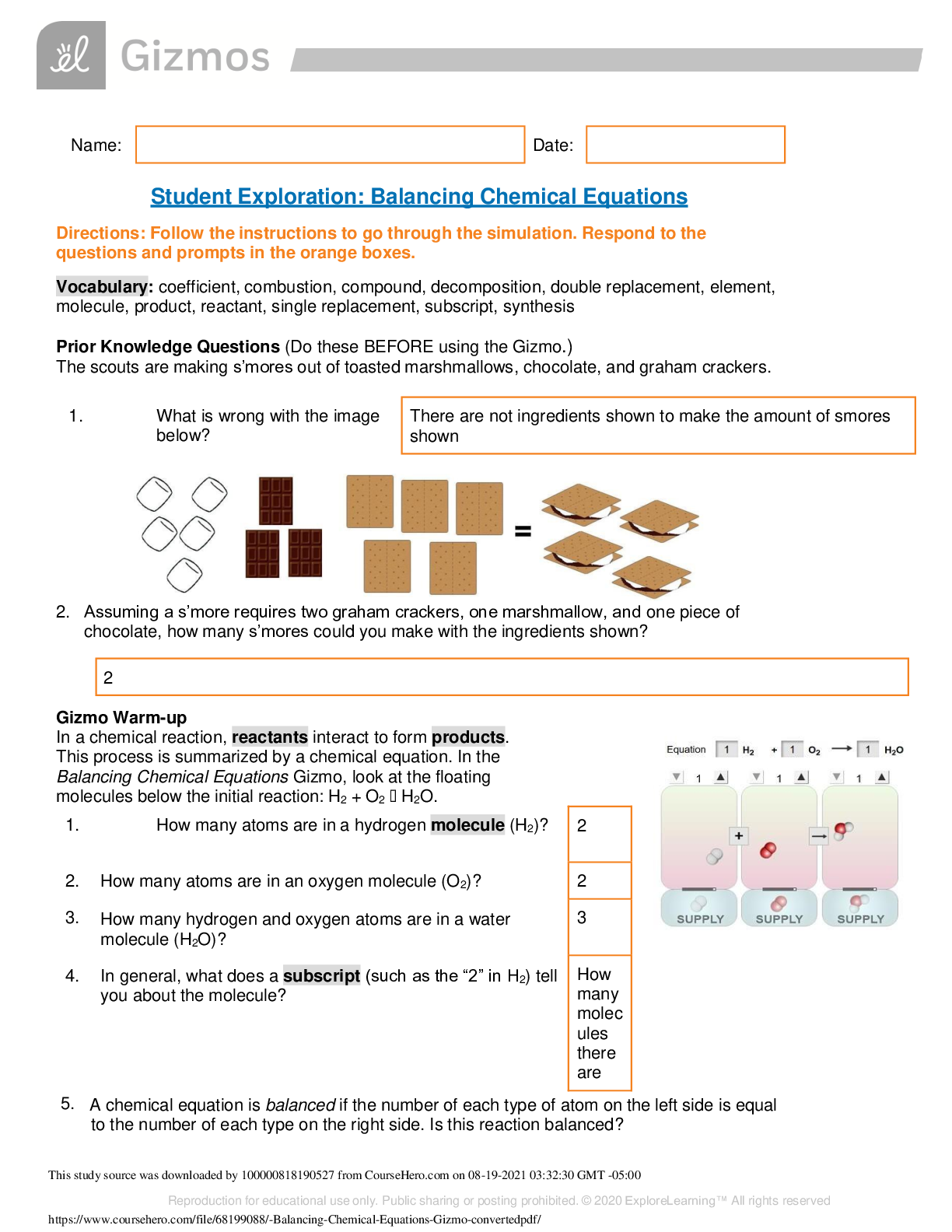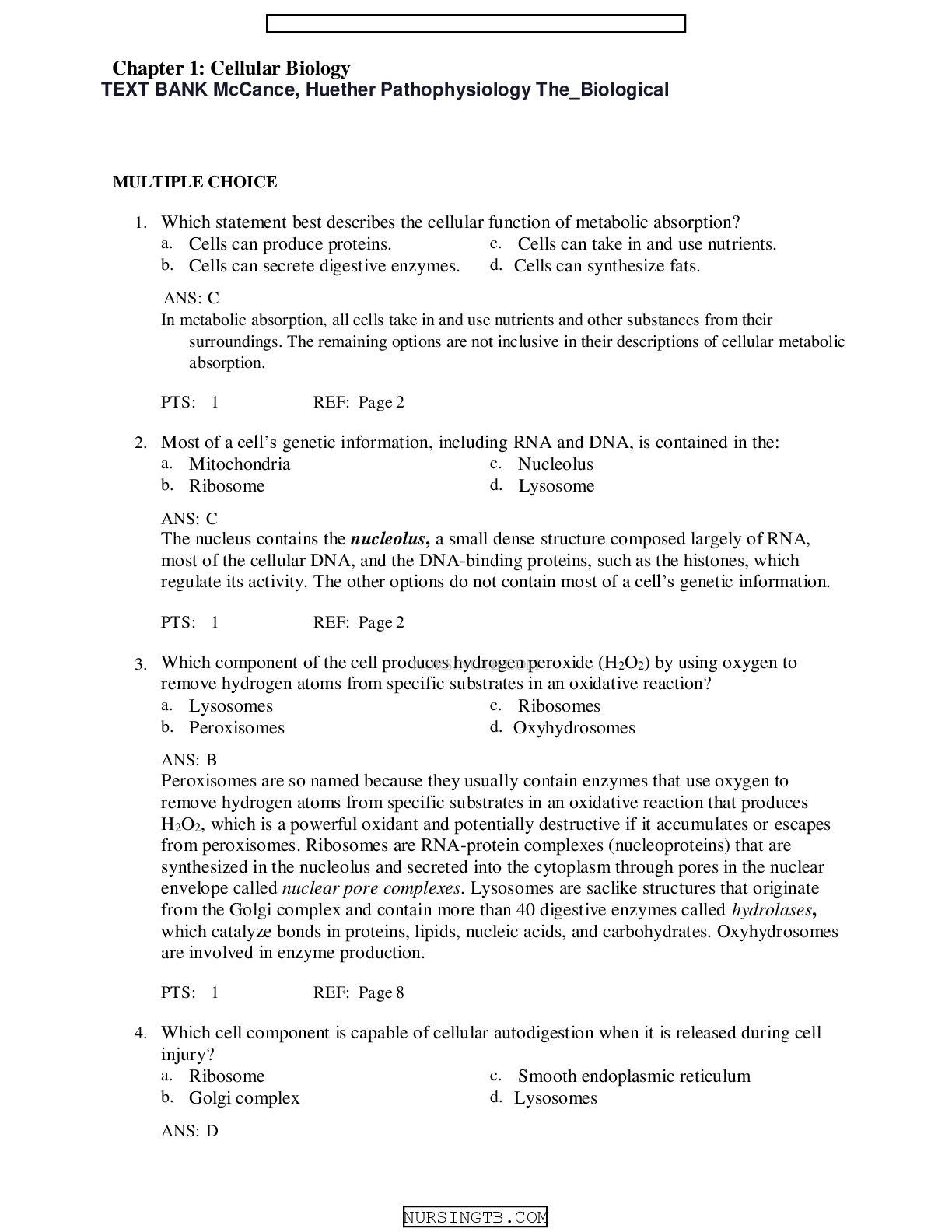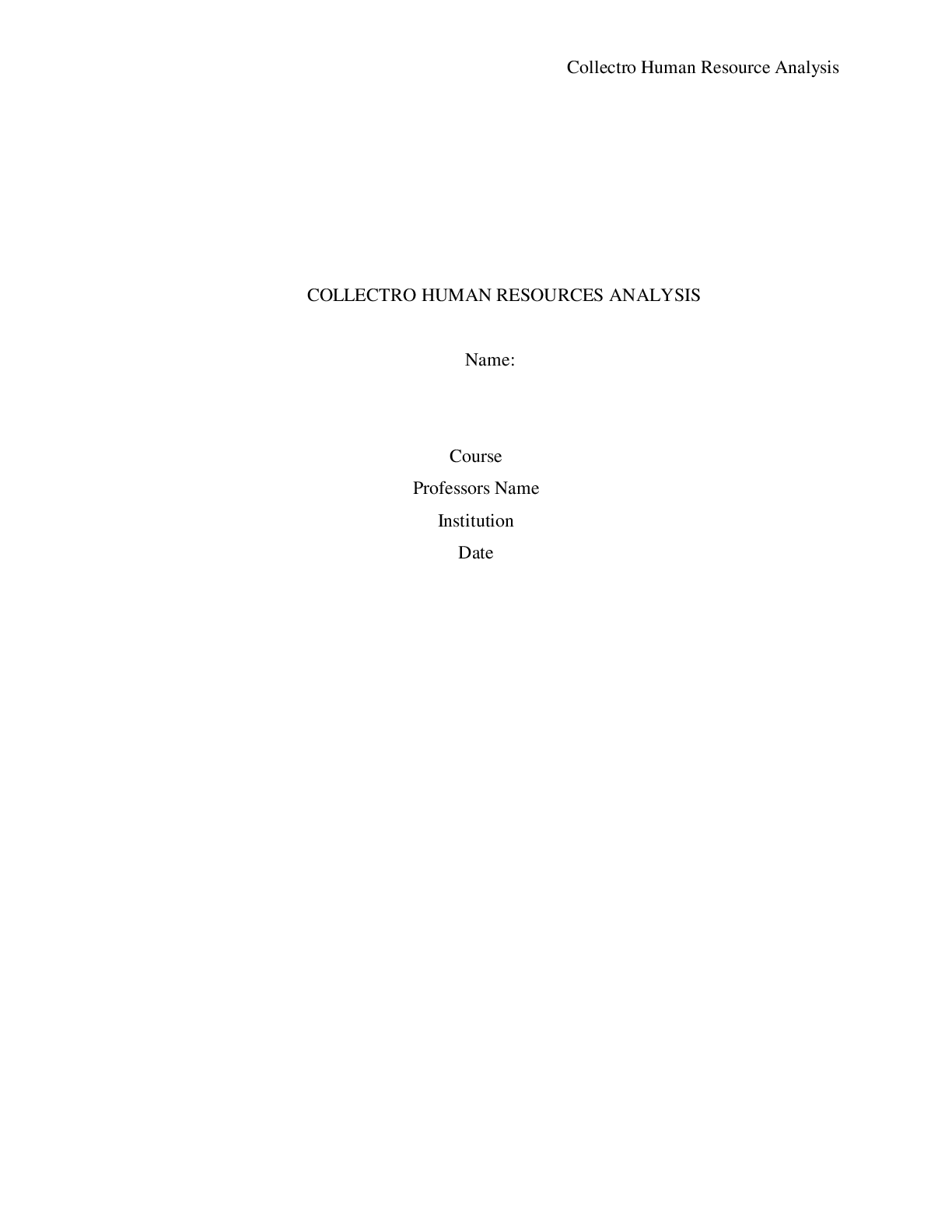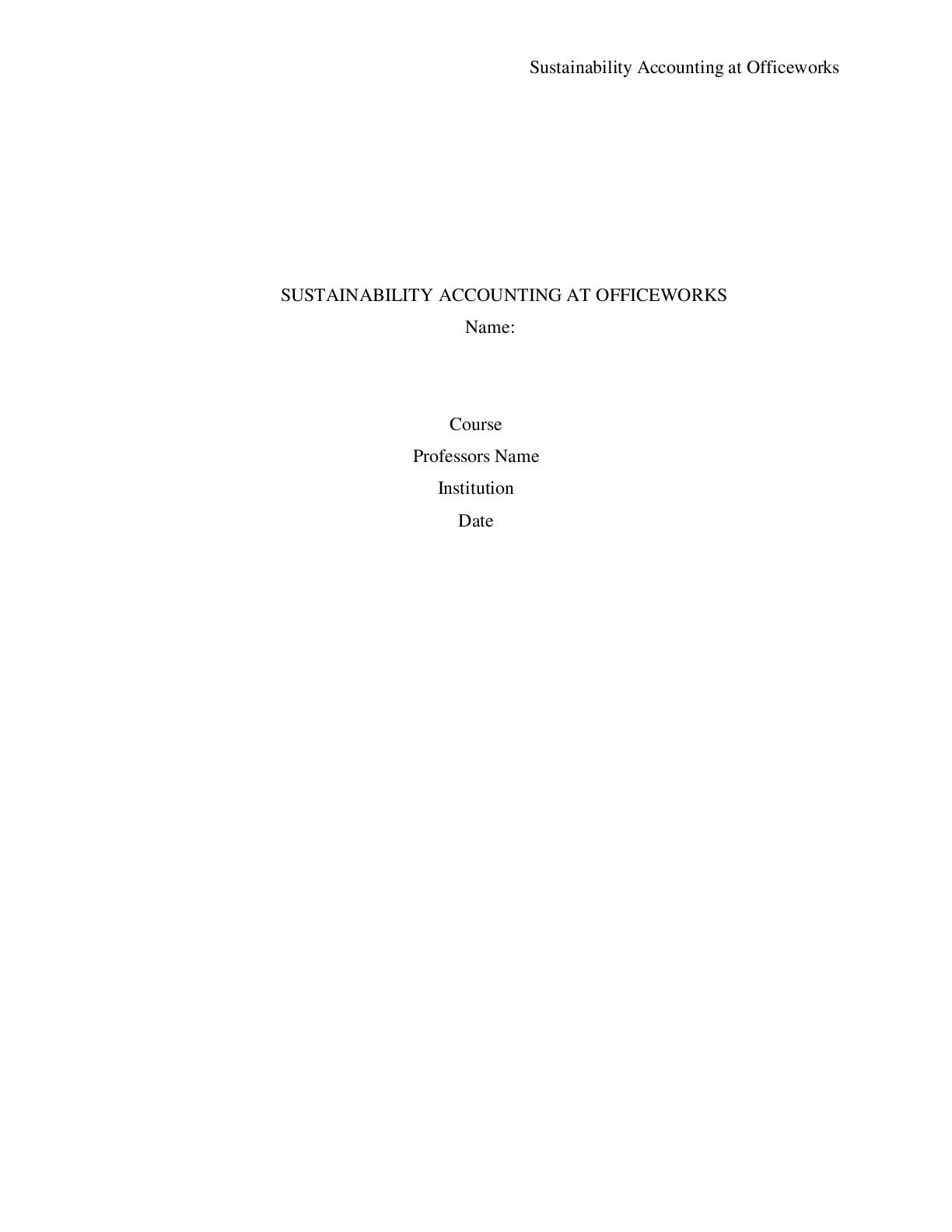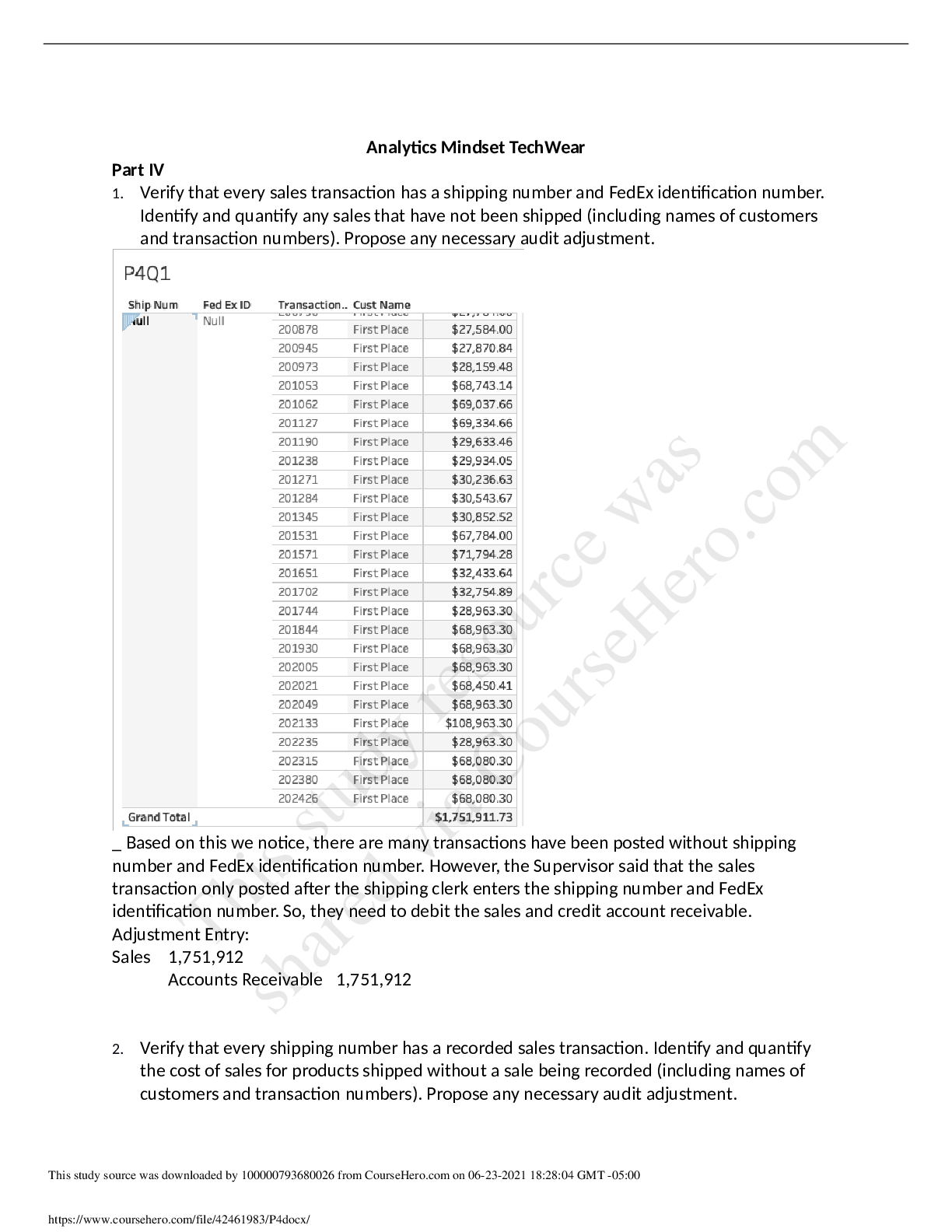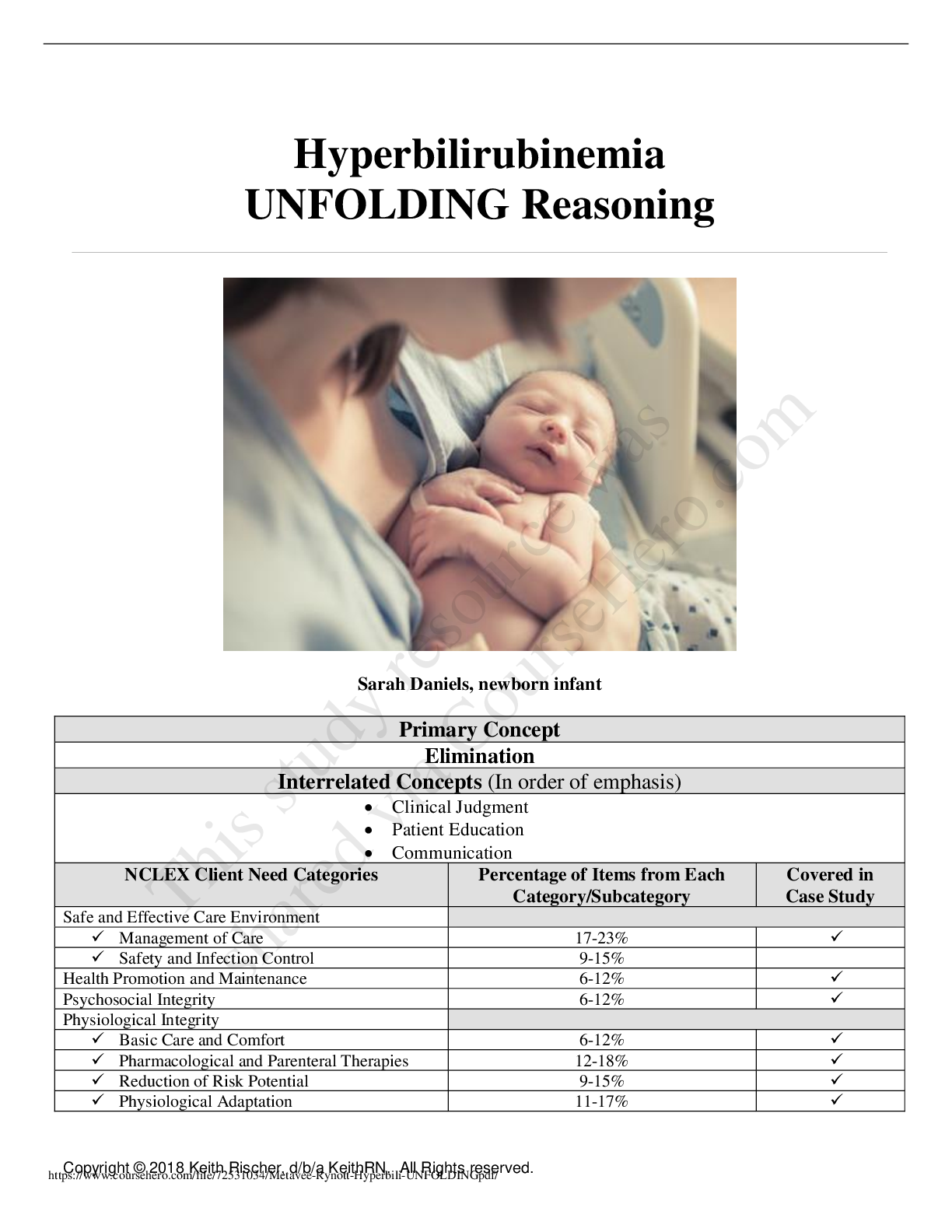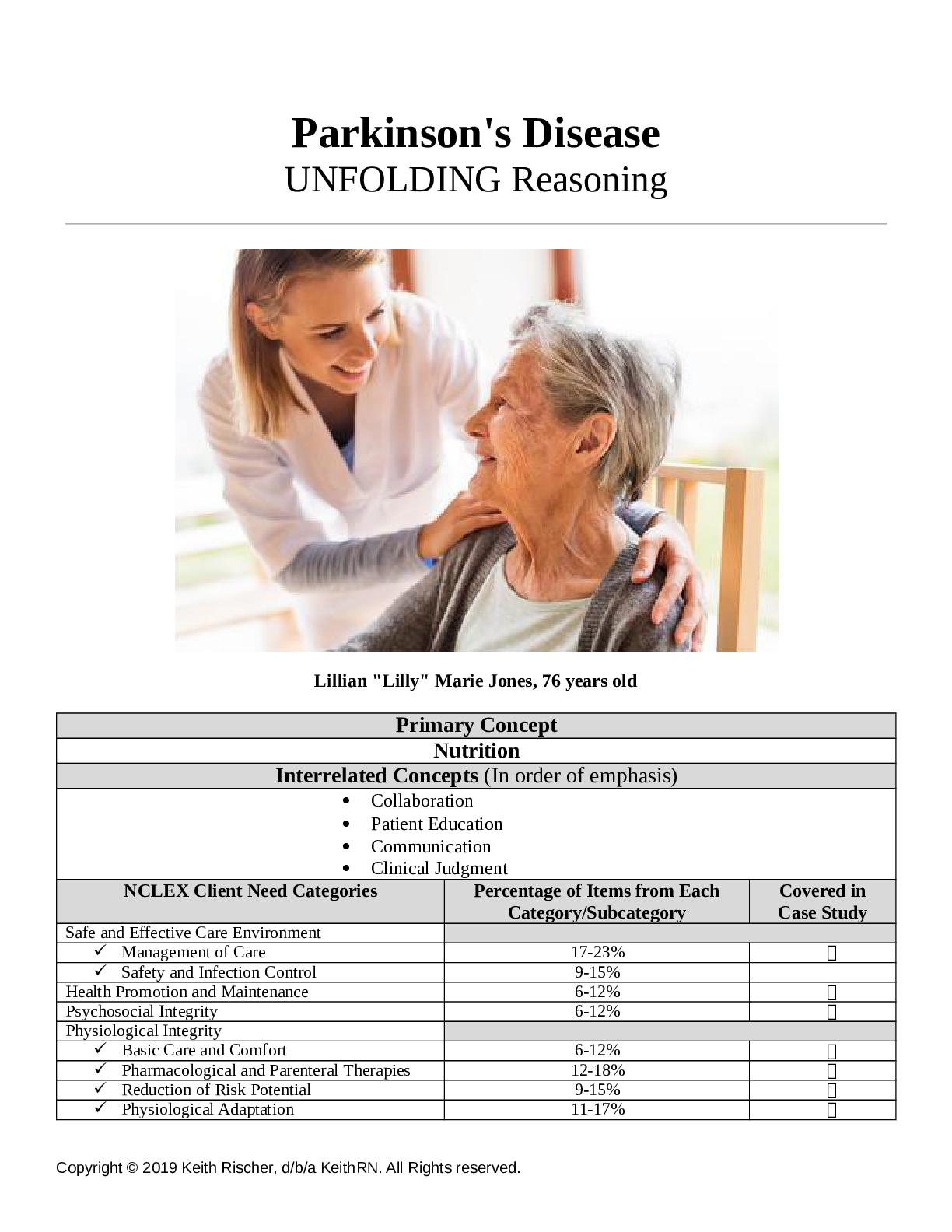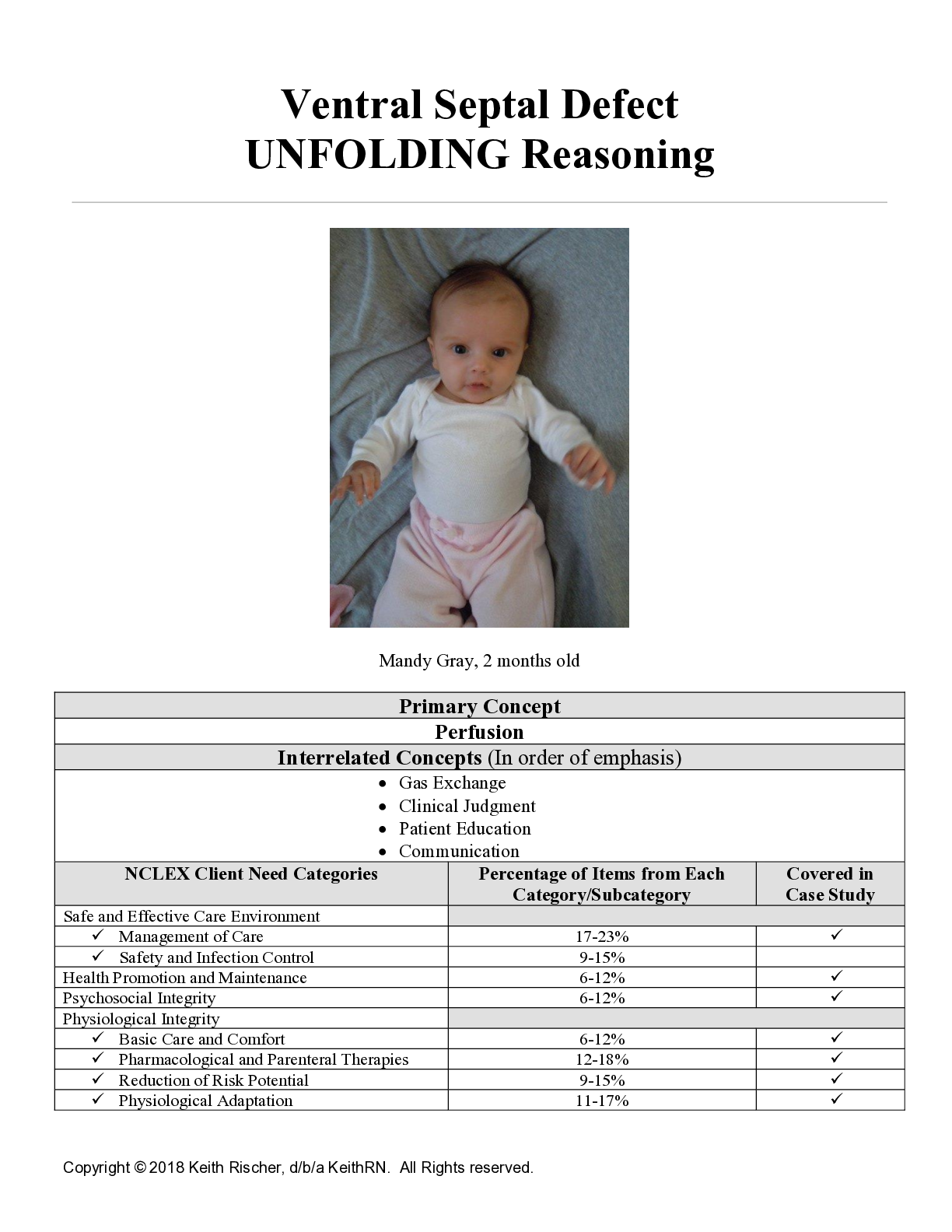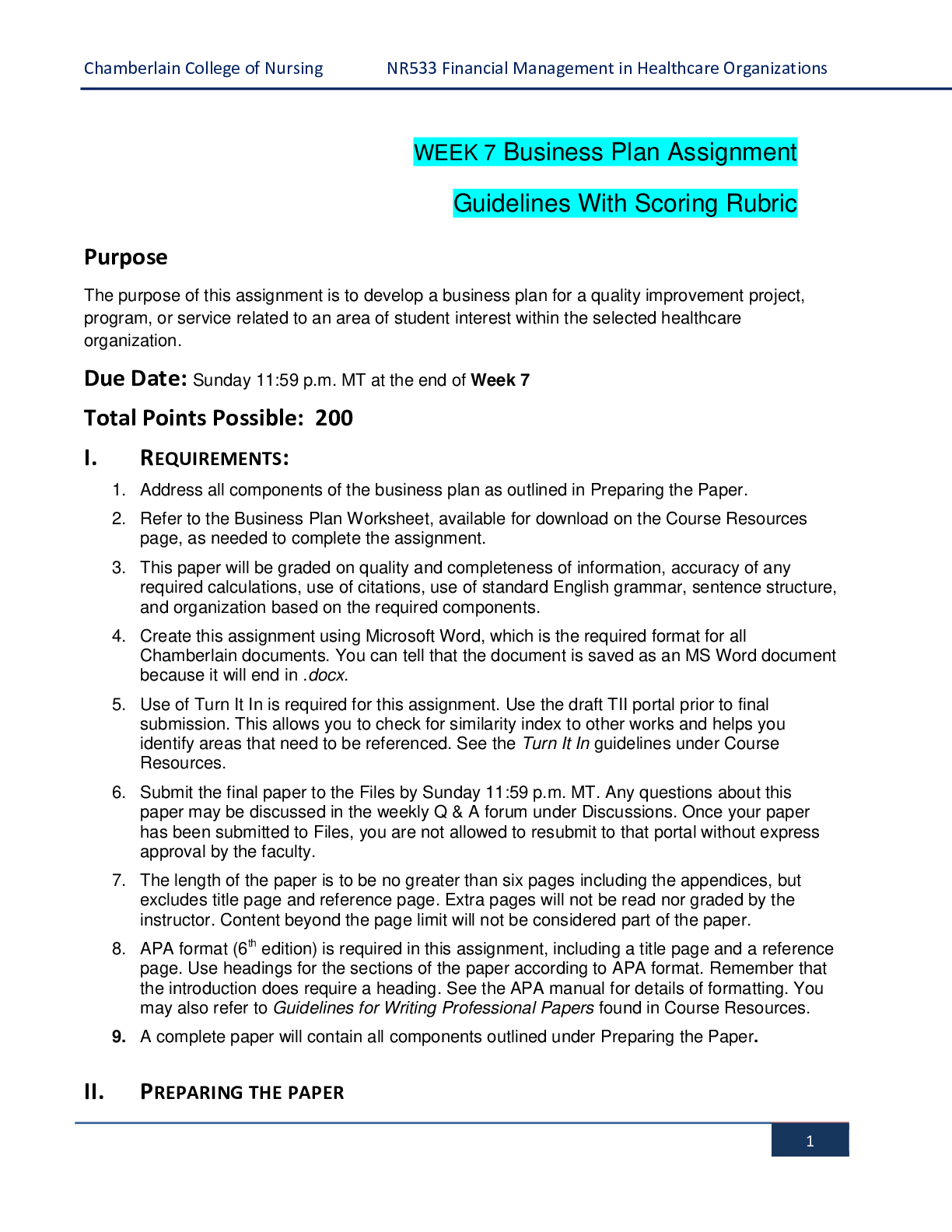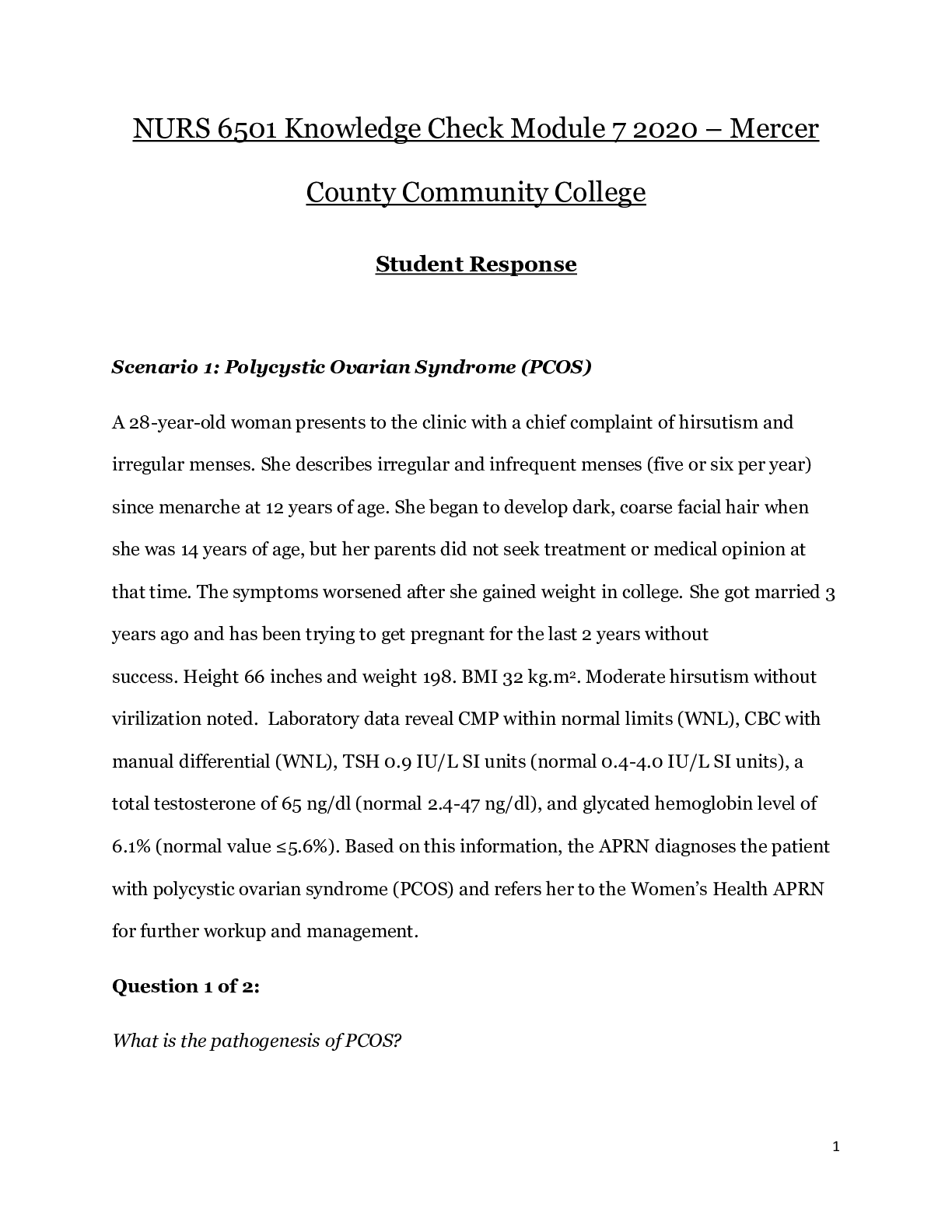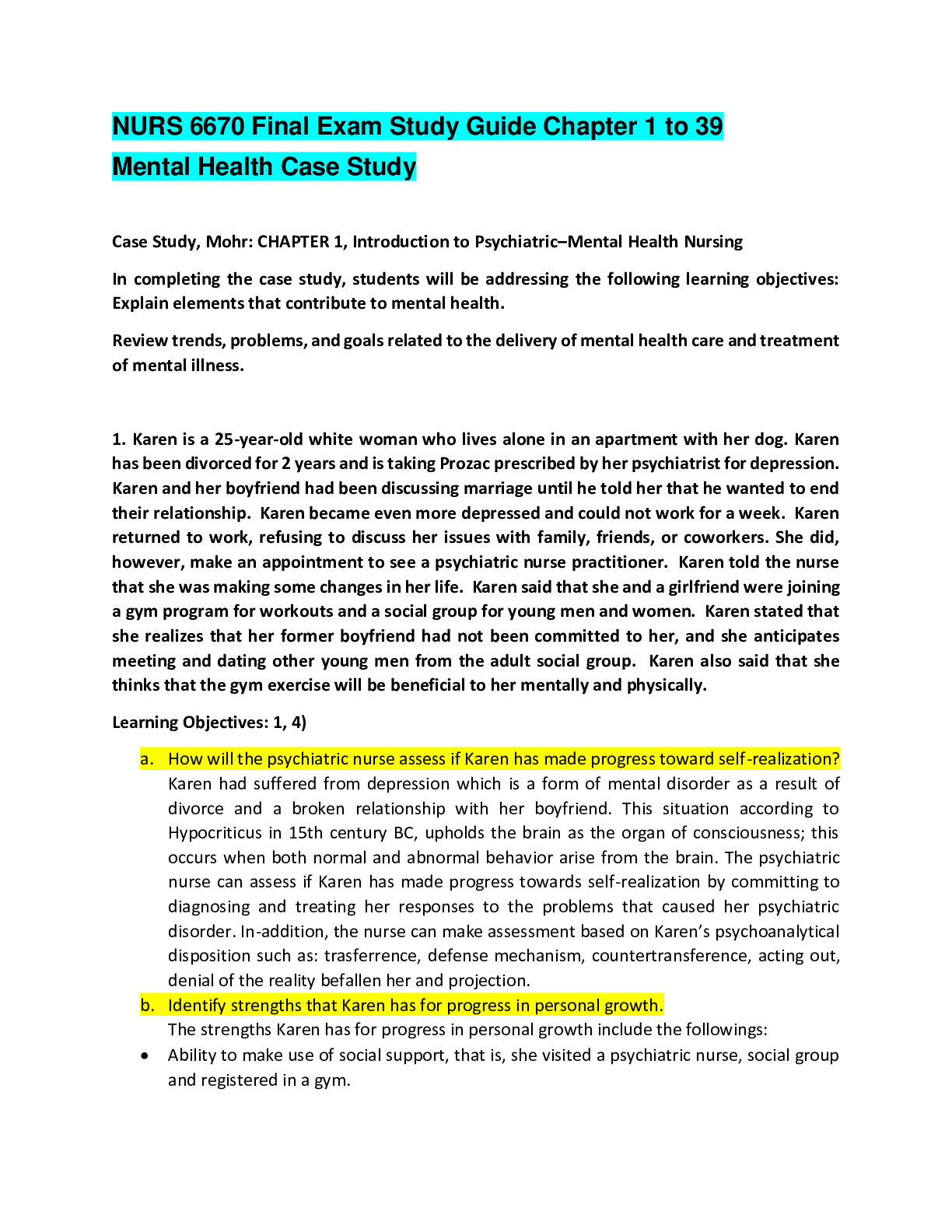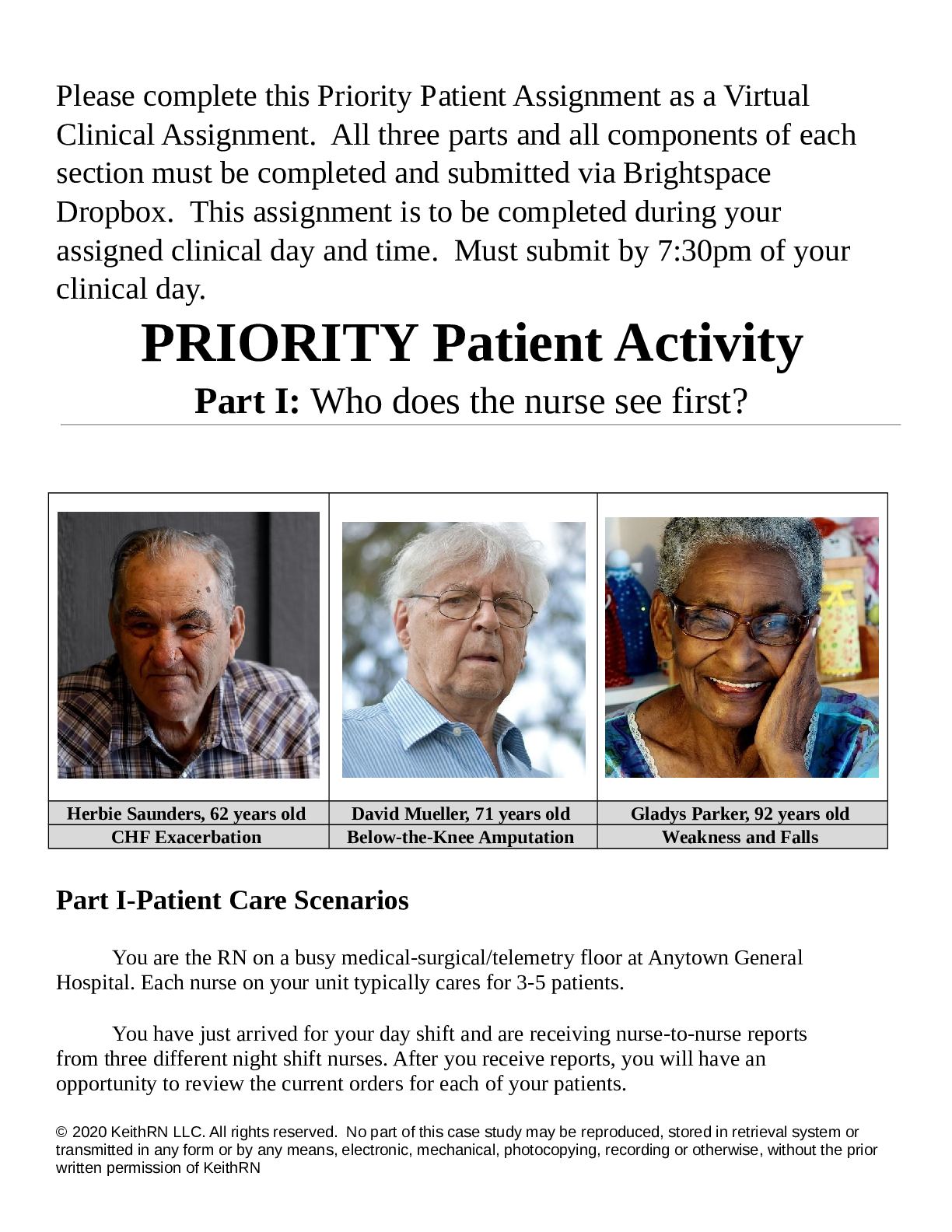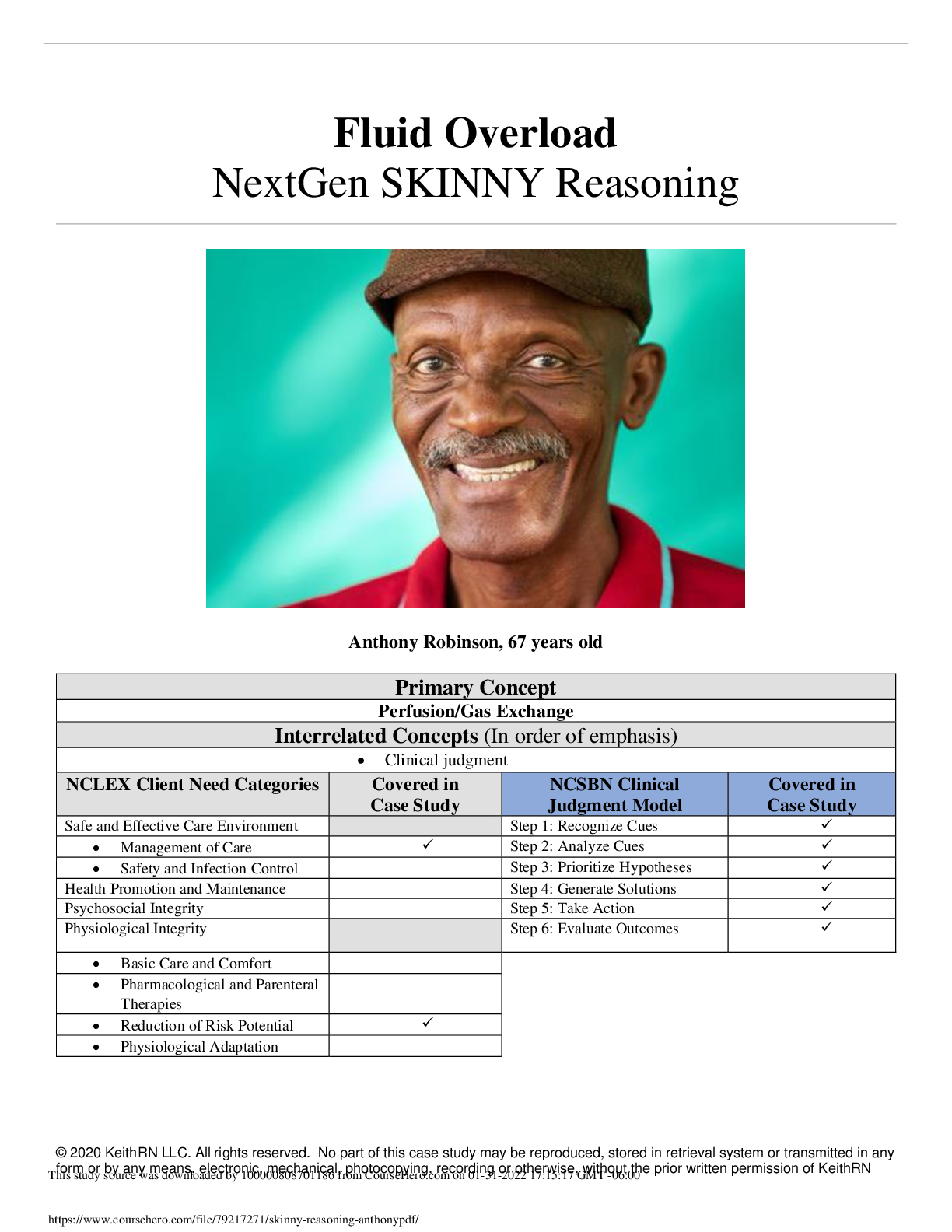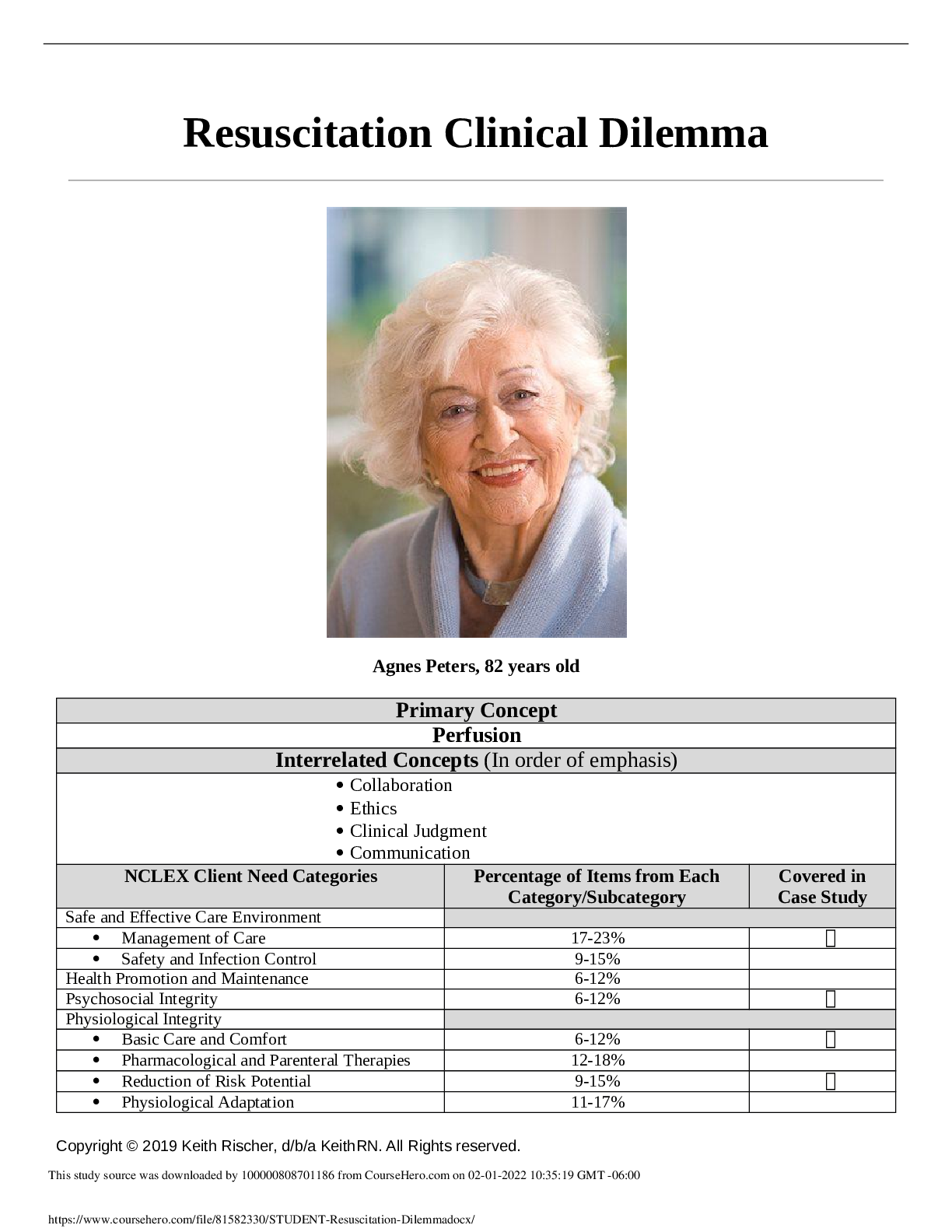*NURSING > CASE STUDY > NURS6630 FINAL EXAM Latest Study Guide: WALDEN UNIVERSITY: Attempt Score 74/75. (All)
NURS6630 FINAL EXAM Latest Study Guide: WALDEN UNIVERSITY: Attempt Score 74/75.
Document Content and Description Below
NURS6630 FINAL EXAM (Latest): WALDEN UNIVERSITY QUESTION 1 What will the PMHNP most likely prescribe to a patient with psychotic aggression who needs to manage the top-down cortical control and the e ... xcessive drive from striatal hyperactivity? A. Stimulants B. Antidepressants C. Antipsychotics D. SSRIs QUESTION 2 The PMHNP is selecting a medication treatment option for a patient who is exhibiting psychotic behaviors with poor impulse control and aggression. Of the available treatments, which can help temper some of the adverse effects or symptoms that are normally caused by D2 antagonism? A. First-generation, conventional antipsychotics B. First-generation, atypical antipsychotics C. Second-generation, conventional antipsychotics D. Second-generation, atypical antipsychotics QUESTION 3 The PMHNP is discussing dopamine D2 receptor occupancy and its association with aggressive behaviors in patients with the student. Why does the PMHNP prescribe a standard dose of atypical antipsychotics? A. The doses are based on achieving 100% D2 receptor occupancy. B. The doses are based on achieving a minimum of 80% D2 receptor occupancy. C. The doses are based on achieving 60% D2 receptor occupancy. D. None of the above. QUESTION 4 Why does the PMHNP avoid prescribing clozapine (Clozaril) as a first-line treatment to the patient with psychosis and aggression? A. There is too high a risk of serious adverse side effects. B. It can exaggerate the psychotic symptoms. C. Clozapine (Clozaril) should not be used as high-dose monotherapy. D. There is no documentation that clozapine (Clozaril) is effective for patients who are violent. QUESTION 5 The PMHNP is caring for a patient on risperidone (Risperdal). Which action made by the PMHNP exhibits proper care for this patient? A. Explaining to the patient that there are no risks of EPS B. Prescribing the patient 12 mg/dail C. Titrating the dose by increasing it every 5–7 days D. Writing a prescription for a higher dose of oral risperidone (Risperdal) to achieve high D2 receptor occupancy QUESTION 6 The PMHNP wants to prescribe Mr. Barber a mood stabilizer that will target aggressive and impulsive symptoms by decreasing dopaminergic neurotransmission. Which mood stabilizer will the PMHNP select? A. Lithium (Lithane) B. Phenytoin (Dilantin) C. Valproate (Depakote) D. Topiramate (Topamax) QUESTION 7 The parents of a 7-year-old patient with ADHD are concerned about the effects of stimulants on their child. The parents prefer to start pharmacological treatment with a non-stimulant. Which medication will the PMHNP will most likely prescribe? A. Strattera B. Concerta C. Daytrana D. Adderall QUESTION 8 8 The PMHNP understands that slow-dose extended release stimulants are most appropriate for which patient with ADHD? A. 8-year-old patient B. 24-year-old patient C. 55-year-old patient D. 82-year-old patient QUESTION 9 A patient is prescribed D-methylphenidate, 10-mg extended-release capsules. What should the PMHNP include when discussing the side effects with the patient? A. The formulation can have delayed actions when taken with food. B. Sedation can be a common side effect of the drug. C. The medication can affect your blood pressure. D. This drug does not cause any dependency. QUESTION 10 The PMHNP is teaching parents about their child’s new prescription for Ritalin. What will the PMHNP include in the teaching? A. The second dose should be taken at lunch. B. There are no risks for insomnia. C. There is only one daily dose, to be taken in the morning. D. There will be continued effects into the evening. QUESTION 11 A young patient is prescribed Vyvanse. During the follow-up appointment, which comment made by the patient makes the PMHNP think that the dosing is being done incorrectly? A. “I take my pill at breakfast.” B. “I am unable to fall asleep at night.” C. “I feel okay all day long.” D. “I am not taking my pill at lunch.” QUESTION 12 A 14-year-old patient is prescribed Strattera and asks when the medicine should be taken. What does the PMHNP understand regarding the drug’s dosing profile? A. The patient should take the medication at lunch. B. The patient will have one or two doses a day. C. The patient will take a pill every 17 hours. D. The dosing should be done in the morning and at night. QUESTION 13 The PMHNP is meeting with the parents of an 8-year-old patient who is receiving an initial prescription for D-amphetamine. The PMHNP demonstrates appropriate prescribing practices when she prescribes the following dose: A. The child will be prescribed 2.5 mg. B. The child will be prescribed a 10-mg tablet. C. The child’s dose will increase by 2.5 mg every other week. D. The child will take 10–40 mg, daily. QUESTION 14 A patient is being prescribed bupropion and is concerned about the side effects. What will the PMHNP tell the patient regarding bupropion? A. Weight gain is not unusual. B. Sedation may be common. C. It can cause cardiac arrhythmias. D. It may amplify fatigue. QUESTION 15 Which patient will receive a lower dose of guanfacine? A. Patient who has congestive heart failure B. Patient who has cerebrovascular disease C. Patient who is pregnant D. Patient with kidney disease QUESTION 16 An 18-year-old female with a history of frequent headaches and a mood disorder is prescribed topiramate (Topamax), 25 mg by mouth daily. The PMHNP understands that this medication is effective in treating which condition(s) in this patient? A. Migraines B. Bipolar disorder and depression C. Pregnancy-induced depression D. Upper back pain QUESTION 17 The PMHNP is treating a patient for fibromyalgia and is considering prescribing milnacipran (Savella). When prescribing this medication, which action is the PMHNP likely to choose? A. Monitor liver function every 6 months for a year and then yearly thereafter. B. Monitor monthly weight. C. Split the daily dose into two doses after the first day. D. Monitor for occult blood in the stool. QUESTION 18 The PMHNP is assessing a patient she has been treating with the diagnosis of chronic pain. During the assessment, the patient states that he has recently been having trouble getting to sleep and staying asleep. Based on this information, what action is the PMHNP most likely to take? A. Order hydroxyzine (Vistaril), 50 mg PRN or as needed B. Order zolpidem (Ambien), 5mg at bedtime C. Order melatonin, 5mg at bedtime D. Order quetiapine (Seroquel), 150 mg at bedtime QUESTION 19 The PMHNP is assessing a female patient who has been taking lamotrigine (Lamictal) for migraine prophylaxis. After discovering that the patient has reached the maximum dose of this medication, the PMHNP decides to change the patient’s medication to zonisamide (Zonegran). In addition to evaluating this patient’s day-to-day activities, what should the PMHNP ensure that this patient understands? A. Monthly blood levels must be drawn. B. ECG monitoring must be done once every 3 months. C. White blood cell count must be monitored weekly. D. This medication has unwanted side effects such as sedation, lack of coordination, and drowsiness. QUESTION 20 A patient recovering from shingles presents with tenderness and sensitivity to the upper back. He states it is bothersome to put a shirt on most days. This patient has end stage renal disease (ESRD) and is scheduled to have hemodialysis tomorrow but states that he does not know how he can lie in a recliner for 3 hours feeling this uncomfortable. What will be the PMHNP’s priority? A. Order herpes simplex virus (HSV) antibody testing B. Order a blood urea nitrogen (BUN) and creatinine STAT C. Prescribe lidocaine 5% D. Prescribe hydromorphone (Dilaudid) 2mg QUESTION 21 The PMHNP prescribed a patient lamotrigine (Lamictal), 25 mg by mouth daily, for nerve pain 6 months ago. The patient suddenly presents to the office with the complaint that the medication is no longer working and complains of increased pain. What action will the PMHNP most likely take? A. Increase the dose of lamotrigine (Lamictal) to 25 mg twice daily. B. Ask if the patient has been taking the medication as prescribed. C. Order gabapentin (Neurontin), 100 mg three times a day, because lamotrigine (Lamictal) is no longer working for this patient. D. Order a complete blood count (CBC) to assess for an infection. QUESTION 22 An elderly woman with a history of Alzheimer’s disease, coronary artery disease, and myocardial infarction had a fall at home 3 months ago that resulted in her receiving an open reduction internal fixation. While assessing this patient, the PMHNP is made aware that the patient continues to experience mild to moderate pain. What is the PMHNP most likely to do? A. Order an X-ray because it is possible that she dislocated her hip. B. Order ibuprofen (Motrin) because she may need long-term treatment and chronic pain is not uncommon. C. Order naproxen (Naprosyn) because she may have arthritis and chronic pain is not uncommon. D. Order Morphine and physical therapy. QUESTION 23 The PMHNP is assessing a 49-year-old male with a history of depression, post-traumatic stress disorder (PTSD), alcoholism with malnutrition, diabetes mellitus type 2, and hypertension. His physical assessment is unremarkable with the exception of peripheral edema bilaterally to his lower extremities and a chief complaint of pain with numbness and tingling to each leg 5/10. The PMHNP starts this patient on a low dose of doxepin (Sinequan). What is the next action that must be taken by the PMHNP? A. Orders liver function tests. B. Educate the patient on avoiding grapefruits when taking this medication. C. Encourage this patient to keep fluids to 1500 ml/day until the swelling subsides. D. Order a BUN/Creatinine test. QUESTION 24 The PMHNP is evaluating a 30-year-old female patient who states that she notices pain and a drastic change in mood before the start of her menstrual cycle. The patient states that she has tried diet and lifestyle changes but nothing has worked. What will the PMHNP most likely do? A. Prescribe Estrin FE 24 birth control B. Prescribe ibuprofen (Motrin), 800 mg every 8 hours as needed for pain C. Prescribe desvenlafaxine (Pristiq), 50 mg daily D. Prescribe risperidone (Risperdal), 2 mg TID QUESTION 25 A patient with chronic back pain has been prescribed a serotonin-norepinephrine reuptake inhibitor (SNRI). How does the PMHNP describe the action of SNRIs on the inhibition of pain to the patient? A. “The SNRI can increase noradrenergic neurotransmission in the descending spinal pathway to the dorsal horn.” B. “The SNRI can decrease noradrenergic neurotransmission in the descending spinal pathway to the dorsal horn.” C. “The SNRI can reduce brain atrophy by slowing the gray matter loss in the dorsolateral prefrontal cortex.” D. “The SNRI can increase neurotransmission to descending neurons.” QUESTION 26 A patient with fibromyalgia and major depression needs to be treated for symptoms of pain. Which is the PMHNP most likely to prescribe for this patient? Venlafaxine (Effexor) Duloxetine (Cymbalta) Clozapine (Clozaril) Phenytoin (Dilantin) QUESTION 27 The PMHNP prescribes gabapentin (Neurontin) for a patient’s chronic pain. How does the PMHNP anticipate the drug to work? A. It will bind to the alpha-2-delta ligand subunit of voltage-sensitive calcium channels. B. It will induce synaptic changes, including sprouting. C. It will act on the presynaptic neuron to trigger sodium influx. D. It will inhibit activity of dorsal horn neurons to suppress body input from reaching the brain. QUESTION 28 Mrs. Rosen is a 49-year-old patient who is experiencing fibro-fog. What does the PMHNP prescribe for Mrs. Rosen to improve this condition? A. Venlafaxine (Effexor) B. Armodafinil (Nuvigil) C. Bupropion (Wellbutrin) D. All of the above QUESTION 29 The PMHNP is caring for a patient with fibromyalgia. Which second-line treatment does the PMHNP select that may be effective for managing this patient’s pain? A. Methylphenidate (Ritalin) B. Viloxazine (Vivalan) C. Imipramine (Tofranil) D. Bupropion (Wellbutrin QUESTION 30 The PMHNP is attempting to treat a patient’s chronic pain by having the agent bind the open channel conformation of VSCCs to block those channels with a “use-dependent” form of inhibition. Which agent will the PMHNP most likely select? A. Pregabalin (Lyrica) B. Duloxetine (Cymbalta) C. Modafinil (Provigil) D. Atomoxetine (Strattera) QUESTION 31 A patient with irritable bowel syndrome reports chronic stomach pain. The PMHNP wants to prescribe the patient an agent that will cause irrelevant nociceptive inputs from the pain to be ignored and no longer perceived as painful. Which drug will the PMHNP prescribe? A. Pregabalin (Lyrica) B. Gabapentin (Neurontin) C. Duloxetine (Cymbalta) D. B and C QUESTION 32 The PMHNP wants to use a symptom-based approach to treating a patient with fibromyalgia. How does the PMHNP go about treating this patient? A. Prescribing the patient an agent that ignores the painful symptoms by initiating a reaction known as “fibro-fog” B. Targeting the patient’s symptoms with anticonvulsants that inhibit gray matter loss in the dorsolateral prefrontal cortex C. Matching the patient’s symptoms with the malfunctioning brain circuits and neurotransmitters that might mediate those symptoms D. None of the above QUESTION 33 The PMHNP is working with the student to care for a patient with diabetic peripheral neuropathic pain. The student asks the PMHNP why SSRIs are not consistently useful in treating this particular patient’s pain. What is the best response by the PMHNP? A. “SSRIs only increase norepinephrine levels.” B. “SSRIs only increase serotonin levels.” C. “SSRIs increase serotonin and norepinephrine levels.” D. “SSRIs do not increase serotonin or norepinephrine levels.” QUESTION 34 A patient with gambling disorder and no other psychiatric comorbidities is being treated with pharmacological agents. Which drug is the PMHNP most likely to prescribe? A. Antipsychotics B. Lithium C. SSRI D. Naltrexone QUESTION 35 Kevin is an adolescent who has been diagnosed with kleptomania. His parents are interested in seeking pharmacological treatment. What does the PMHNP tell the parents regarding his treatment options? A. “Naltrexone may be an appropriate option to discuss.” B. “There are many medicine options that treat kleptomania.” C. “Kevin may need to be prescribed antipsychotics to treat this illness.” D. “Lithium has proven effective for treating kleptomania.” QUESTION 36 Which statement best describes a pharmacological approach to treating patients for impulsive aggression? A. Anticonvulsant mood stabilizers can eradicate limbic irritability. B. Atypical antipsychotics can increase subcortical dopaminergic stimulation. C. Stimulants can be used to decrease frontal inhibition. D. Opioid antagonists can be used to reduce drive. QUESTION 37 A patient with hypersexual disorder is being assessed for possible pharmacologic treatment. Why does the PMHNP prescribe an antiandrogen for this patient? A. It will prevent feelings of euphoria. B. It will amplify impulse control. C. It will block testosterone. D. It will redirect the patient to think about other things. QUESTION 38 Mrs. Kenner is concerned that her teenage daughter spends too much time on the Internet. She inquires about possible treatments for her daughter’s addiction. Which response by the PMHNP demonstrates understanding of pharmacologic approaches for compulsive disorders? A. “Compulsive Internet use can be treated similarly to how we treat people with substance use disorders.” B. “Internet addiction is treated with drugs that help block the tension/arousal state your daughter experiences.” C. “When it comes to Internet addiction, we prefer to treat patients with pharmaceuticals rather than psychosocial methods.” D. “There are no evidence-based treatments for Internet [Show More]
Last updated: 1 year ago
Preview 1 out of 16 pages
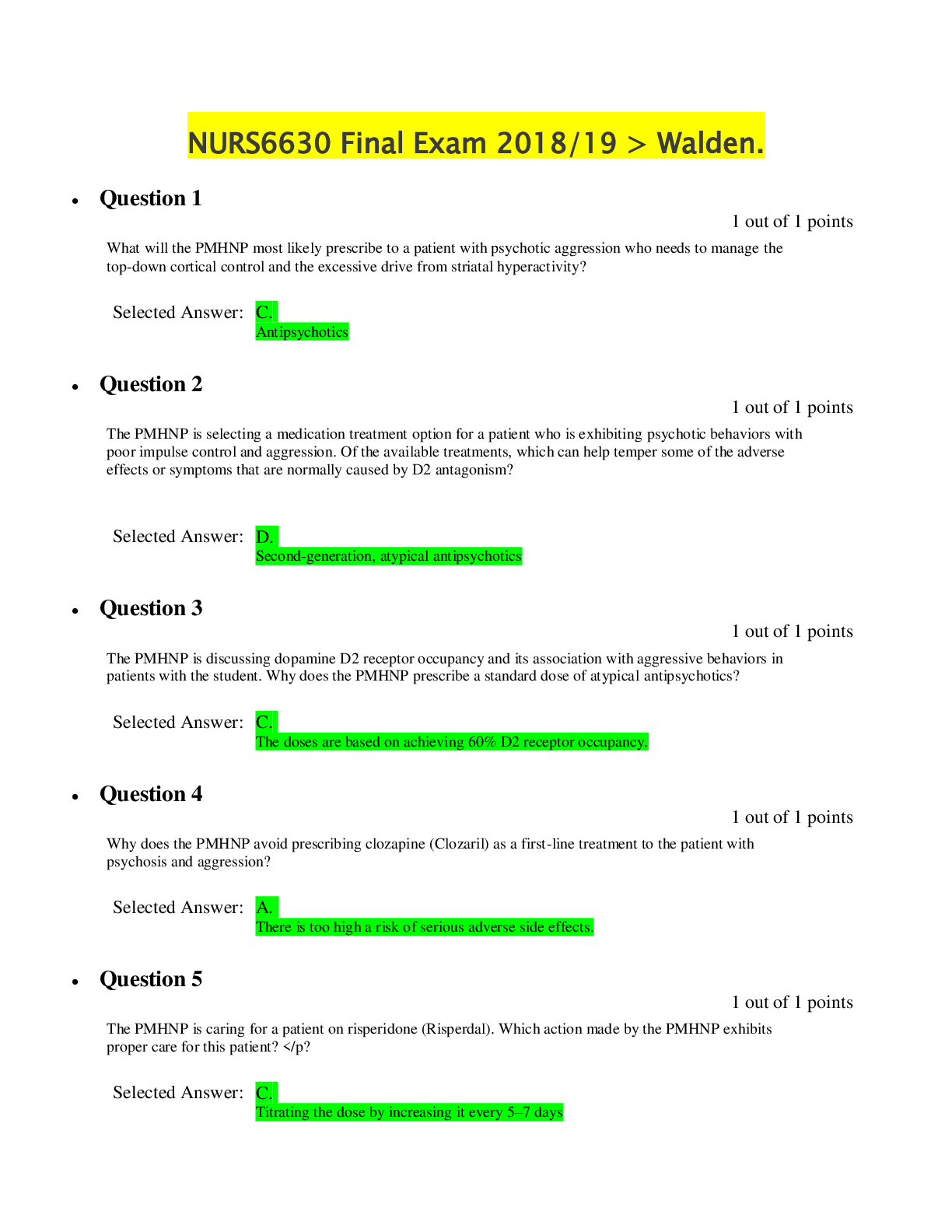
Reviews( 0 )
Document information
Connected school, study & course
About the document
Uploaded On
Jun 09, 2021
Number of pages
16
Written in
Additional information
This document has been written for:
Uploaded
Jun 09, 2021
Downloads
0
Views
54

